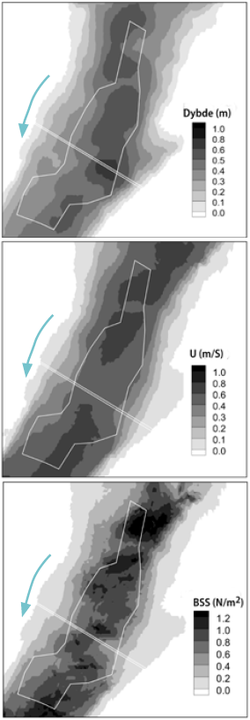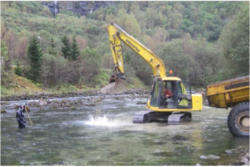Difference between revisions of "Environmental design of embankments and erosion protection"
Bendikhansen (talk | contribs) |
Bendikhansen (talk | contribs) |
||
| Line 1: | Line 1: | ||
| + | =Introduction= | ||
| + | [[file:env_design_embankments_otta|thumb|250px|Figure 1: Construction of embankments with stones at the inter-section of Otta River and Gudbrandsdalslågen in Norway, for the purpose of protecting the nearby houses and infrastructure (Photo: Tor Haakon Bakken).]] | ||
| + | [[file:spawning_gravel_openfoam.png|thumb|250px|Figure 2: ]] | ||
| + | [[file:spawning_gravel_excavator.png|thumb|250px|Figure 3: Excavator placing spawning gravel in a river.]] | ||
| + | |||
| + | Embankments and erosion protections are put in place in many rivers to reduce the erosion that ultimately might threat infrastructure. In highly urbanised areas or areas of critical infrastructure, the protection is so extensive that rivers are completely channelized. In many cases this protection is made of concrete blocks with close to smooth surfaces, providing no or little hydraulic variation and shelter for fish along the shoreline. Sometimes, the man-made embankment is also placed a bit into the river, reducing the total available habitat. | ||
| + | |||
| + | Environmental designed embankments could be introduced by replacing smooth-surface concrete with stones of rougher surfaces providing more hydraulic diversity and shelter. The embankments should also be placed into the very shore of the river to maximize the areas available for the aquatic environment. | ||
| + | |||
| + | It can be unrealistic to re-build existing embankment for the purpose of improving the conditions for fish, but if the embankments for other reasons should be re-built or new embankments should be put in place, they should be designed in an environmentally friendly way. | ||
| + | |||
| + | A variant of embankment is called 'rip-raps', which are basically rough stones dumped by the shore of the river with the primary purpose to reduce erosion. If rip-raps are designed with care, they can also sustain or improve the ecological conditions along the shore. An alternative is to use anchored dead trees or other types of current deflectors for bank protection. Ultimately, the removal of bank protection is of course a way of improving the ecological function, if possible weighed against other impacts. | ||
| + | |||
| + | =[[Methods, tools, and devices]]= | ||
| + | |||
| + | ==During planning== | ||
| + | |||
| + | ==During implementation== | ||
| + | |||
| + | ==During operation== | ||
| + | |||
| + | =Classification Table= | ||
| + | |||
[[category:Habitat measures]][[category:Measures]] | [[category:Habitat measures]][[category:Measures]] | ||
Revision as of 09:28, 22 June 2019
Contents
Introduction
Embankments and erosion protections are put in place in many rivers to reduce the erosion that ultimately might threat infrastructure. In highly urbanised areas or areas of critical infrastructure, the protection is so extensive that rivers are completely channelized. In many cases this protection is made of concrete blocks with close to smooth surfaces, providing no or little hydraulic variation and shelter for fish along the shoreline. Sometimes, the man-made embankment is also placed a bit into the river, reducing the total available habitat.
Environmental designed embankments could be introduced by replacing smooth-surface concrete with stones of rougher surfaces providing more hydraulic diversity and shelter. The embankments should also be placed into the very shore of the river to maximize the areas available for the aquatic environment.
It can be unrealistic to re-build existing embankment for the purpose of improving the conditions for fish, but if the embankments for other reasons should be re-built or new embankments should be put in place, they should be designed in an environmentally friendly way.
A variant of embankment is called 'rip-raps', which are basically rough stones dumped by the shore of the river with the primary purpose to reduce erosion. If rip-raps are designed with care, they can also sustain or improve the ecological conditions along the shore. An alternative is to use anchored dead trees or other types of current deflectors for bank protection. Ultimately, the removal of bank protection is of course a way of improving the ecological function, if possible weighed against other impacts.

